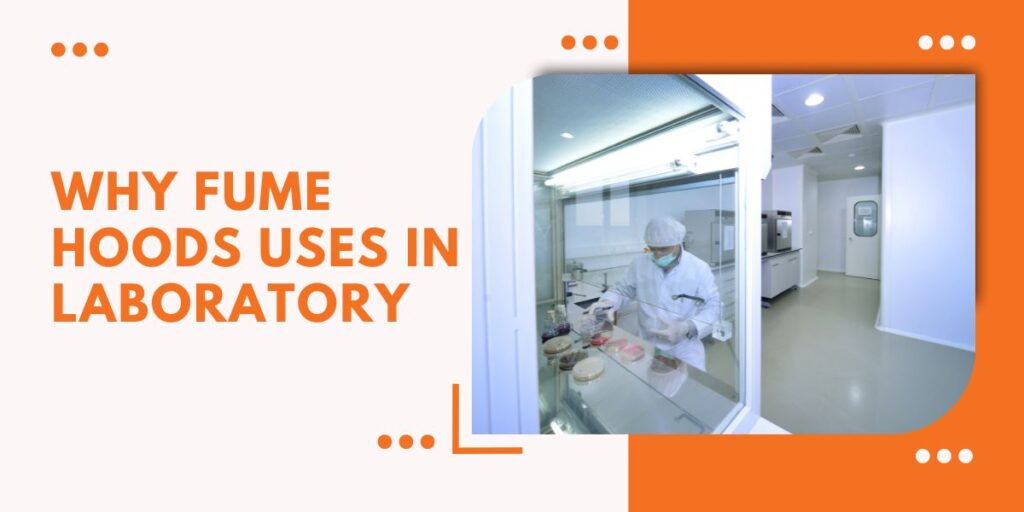The fume hood is safety equipment in the laboratory with a special design that will reduce exposure to harmful gases, dust, and toxic vapors. It is a structure like a box enclosing a source of potential air contamination with one open or partially open side, into which air is moved for the purpose of containing and exhausting air contaminants. In this blog, we will discuss why fume hoods uses in laboratory, what are fume hoods, the types of fume hoods, and how does a fume hood works.
What are Fume Hoods?
A fume hood is also known as various names like chemical hood or safety cabinet. It is basically an aerodynamic cleaning device that has a large cupboard at the bottom that functions as a place or table. The main use of a fume hood is to protect laboratory workers from toxic fumes, harmful gases, and dangerous acids when working with various chemicals.
Types of Fume Hoods.
There are mainly 4 types of fume hoods.
- Standard Fume Hood
The standard fume hood is the most common type of fume hood. It is also known as a constant air volume (CAV) hood because it is exhaust airflow with variable face velocity. CAV hood is a classic and typically less decorative hood. It is designed to use for workers to protect in general.
In a standard fume hood, the amount of exhausted air is constant hence the relationship between the face velocity and sash height in a CAV hood is inverse. It means the face velocity increase as the sash is lowered. It is possible to install a CAV hood with and without a bypass provision, which is an additional air supply aperture.
- Bypass Fume Hood
A better version of the standard fume hood is the bypass fume hood. The bypass is protected by a grille and is situated above the sash face opening that aids in directing airflow.
The bypass is designed to deal with the different face velocities that cause air turbulence and air leakage. A relatively consistent amount of exhaust air is maintained independent of the sash position. The Bypass controls the rise in face velocity as the sash approaches the fully closed position.
- Variable Air Volume Fume Hood.
A variable air volume fume hood is created especially to work with the exhaust control systems which are made by other manufacturers that track and regulate how much air is being expelled from the hood.
Instead of a constant air volume system, the adoption of this device will enable airflow to adjust in accordance with the position of the sash. This guarantees that the face velocity will remain steady while working and improves hood performance. This significantly lowers the system’s operational cost and allows you to use less energy.
- Auxiliary Air Fume Hood.
Auxiliary Air Fume Hood is also known as a makeup air fume hood or a bypass fume hood. It was created as a variation on the bypass fume hood and uses less conditioned room air. The auxiliary fume hood is a bypass hood with the addition of directly ducted auxiliary air to supply outside makeup air that is either unconditioned or only partially conditioned.
Auxiliary air fume hoods were intended to reduce the cost of heating and cooling. But because they require more ducting, fans, and air-tempering equipment, they also increase mechanical and operational costs. The operation of the hood will be affected by the air curtain formed unless the volume (and consequently velocity) of auxiliary air is carefully managed. It also may draw vapors out of the inside of the hood. It is not difficult to install this kind of hood.
Learn How does a fume hood work.
The Working principle of the fume hood sucks air from the front door and then the blower is released into the filter. Materials used for fume hoods have the following requirements
- Resistant to organic Chemicals.
- Resistant to Chemicals that are corrosive. (acids and bases)
- Resistant to an explosion.
To learn about the functionality of the fume hood, we have given here the configuration of different parts of the Fume Hood.
1. Sash:- Sash is a sliding door that is a safety guard, usually made of glass or acrylic.
2. Lighting Equipment (position inside the fume hood), a fluorescent lamp for lighting.
3. Top Table Pedestal/work table:- Made of phenolic resin that is resistant to chemicals.
4. Sink:- Where the device washes after the trial to keep it clean.
5. Faucet:- Water tap for washing and rinsing tools.
6. Base cabinet / Storage Cabinet:- To store different types of chemicals.
7. Button Operating Switches:- Consisting of the on-off button to stop contact, power lamp, lamp, and power supply.
8. Sidewall:- Awol that is resistant to steam and chemical pills.
9. Airflow Velocity:- To regulate airflow velocity.
10. Baffles:- They regulate the flow of air so that it can be sucked effectively by the blower.
11. Ducting:- A pipe for air output.
12. Blowers:- A tool that has the function of sucking air and throwing it out.
Now here is the process to use Fume Hood.
- Turn on the lights.
- Turn on the blower switch.
- Raise the sliding window as you wish, if the blower is already then start your working carefully. If at work is waiting while the reaction process is still running, then do it by lowering the sliding window with an opening of about 10 cm from the lip on the table.
- After your work is done, then clean the fume hood table with a dry cloth, then rinse with a wet cloth, then wipe again until dry.
- Turn off the light switch and close the sliding window.
Make sure to close the sliding window tightly when the blower is on, a vacuum will appear in the fume hood.
Conclusion
Fume Hoods are essential for ensuring a secure and regulated laboratory environment for catching and controlling dangerous vapors and gases. There are many options to suit the different needs of laboratory and industrial services. There are several types of fume hoods such as ducted, ductless, and walk-in versions.
With the use of fume hood features and functioning, lab Laboratory staff can work with confidence knowing that their exposure to potentially dangerous compounds is reduced and the environment is safe. Fume hoods are an important tool in any workplace where dangerous materials are used. Because like these places regular maintenance, correct use, and attention to safety regulations are necessary to ensure their efficient and safe operation.




